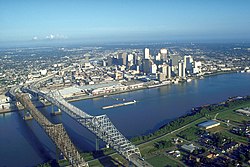Crescent City Connection | |
|---|---|
 | |
| Coordinates | 29°56′19″N 90°03′27″W / 29.93861°N 90.05750°W |
| Carries | 8 lanes of 2 reversible HOV lanes |
| Crosses | Mississippi River |
| Locale | New Orleans, Louisiana, United States |
| Other name(s) | CCC, Greater New Orleans Bridge |
| Maintained by | LA DOTD |
| ID number | 023602830802441 (eastbound) 023602830802442 (westbound) |
| Characteristics | |
| Design | Twin steel truss cantilever bridges |
| Total length | 13,428 ft (4,093 m) |
| Width | 52 ft (16 m) (eastbound) 92 ft (28 m) (westbound) |
| Longest span | 1,575 ft (480 m)[1] 1,594 ft (486 m)[2] |
| Clearance below | 170 ft (52 m) |
| History | |
| Construction cost | $50 million (1958)[3] $550 million (1988)[3] |
| Opened | April 1958 (eastbound) September 1988 (westbound) |
| Statistics | |
| Daily traffic | 180,000[4] 120,000 (2008)[citation needed] |
| Toll | Discontinued (collected 1958-1964 on original span; 1989-2013 on new span) |
| Location | |
 | |

The Crescent City Connection (CCC), formerly the Greater New Orleans (GNO) Bridge, is a pair of cantilever bridges that carry U.S. Highway 90 Business (US 90 Bus.) over the Mississippi River in New Orleans, Louisiana, United States. They are tied as the fifth-longest cantilever bridges in the world. Each span carries four general-use automobile lanes; additionally the westbound span has two reversible HOV lanes across the river.
It is the farthest downstream bridge on the Mississippi River. It is also the widest and most heavily traveled bridge on the lower Mississippi; the only other comparable bridges on the Mississippi are in the St. Louis area, those being the Poplar Street Bridge, the Jefferson Barracks Bridge, and the Stan Musial Veterans Memorial Bridge.
- ^ Crescent City Connection (1958) at Structurae
- ^ Crescent City Connection (1988) at Structurae
- ^ a b "Construction Facts - The Sourcebook of Statistics, Records and Resources" (PDF). Engineering News Record. Vol. 251, no. 20a. McGraw Hill. November 2003. Archived from the original (PDF) on September 4, 2014. Retrieved August 9, 2014.
- ^ Louisiana Department of Transportation and Development. "Tolls to resume on Crescent City Connection bridge, ferries" (Press release). Louisiana Department of Transportation and Development. Archived from the original on October 28, 2005. Retrieved August 16, 2006.
